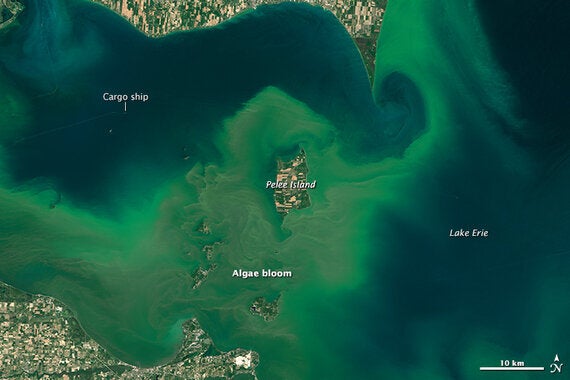
Written by Eric Mysak, Specialist, Freshwater
The Great Lakes watershed is one of a kind. It holds nearly 20 per cent of the world's surface freshwater and supports a population of over 30 million people. Its waters are home to about 250 different species of fish. It's an invaluable ecosystem for so many reasons. But, unfortunately, there's a big problem affecting one of the Great Lakes -- large portions of Lake Erie are being choked by harmful algal blooms.

Algae Bloom in Lake Erie, acquired July 28, 2015. © NASA Earth Observatory
These blooms occur when an excess of nutrients -- especially phosphorous from farm runoff, urban storm water runoff, and wastewater treatment facilities -- enters the lake and promotes large amounts of algae growth which can be seen covering the surface of the water. In Lake Erie, algal blooms have had a significant impact on the ecosystem, causing mass fish kills from large oxygen-depleted "dead zones" and drinking water advisories.
Algal blooms are not a new for Lake Erie. In the 1960s and 70s, blooms were so bad the lake was described as "dead." In response, Canada and the United States signed Great Lakes Water Quality Agreement in 1972, resulting in binational efforts to reduce phosphorous entering the Great Lakes and combat algal blooms. These efforts appeared to work as the lakes showed signs of improving ecological health and fewer algal blooms.
Despite the success of these earlier remedial measures, harmful algal blooms are back and bigger than ever. Algal blooms later this summer are expected to be among the worst ever seen in Lake Erie.
The resurgence of algal blooms in Lake Erie is consistent with the results from WWF's Watershed Reports. In our assessment of the Great Lakes watershed, we found that within the rivers and streams of the Northern Erie sub-watershed, phosphorus levels exceeded water quality guidelines in nearly 80 per cent of water samples taken between 2008 and 2012 (the most recent years included in our analysis).
All signs suggest that unless new adaptive measures are taken to reduce nutrient loads, algal blooms in Lake Erie will only grow worse. And so new actions must be taken, and are on the horizon as governments on both sides of the border are negotiating a new course to lower the amount of nutrients entering the lake.
Notably, under the 2012 amendment to the Great Lakes Water Quality Agreement, Canada and the United States have developed draft phosphorous loading targets which will be adopted in 2016. The subcommittee responsible for providing recommendations have suggested a 40 per cent reduction in phosphorous is needed to combat harmful algal blooms. This 40 per cent reduction target is also the centerpiece of a recent agreement between the governments of Ontario, Ohio and Michigan to reduce phosphorous loads in the western portion of Lake Erie.
Another promising development is the reintroduction of the proposed Great Lakes Protection Act. If passed, the Act would provide the Ontario government additional resources to better protect the Great Lakes against threats such as harmful algal blooms and implement Ontario's Great Lakes Strategy.
There is much to be hopeful about with these recent developments; however, there is still much uncertainty around if and how these measures will be implemented. Their fate will have a large effect on the health of the Great Lakes for years and decades to come -- for better or worse.
ALSO ON HUFFPOST:
